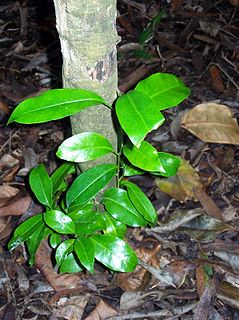
Fontainea is a genus constituting part of the plant family Euphorbiaceae. The nine currently known species grow naturally in Queensland (Qld) and New South Wales (NSW) Australia, New Caledonia and Vanuatu, and Papua New Guinea. Some species are commonly named blushwood.

Nepenthes papuana is a tropical pitcher plant endemic to New Guinea. The specific epithet papuana is derived from Papua, an alternative name for the island.

Mangifera zeylanica or "Sri Lanka wild mango" is a wild species of mango tree endemic to Sri Lanka. This stately tree is the tallest member of the mango genus, Mangifera, and one of the two tallest trees in the family Anacardiaceae. The mango fruits are edible and have an excellent taste. It is called "aetamba" (ඇටඹ) or "wal amba" in Sinhala and “kaddu-ma” in Tamil. The well-known British botanist and explorer Joseph Dalton Hooker first described the tree in 1876.

Cerbera floribunda, commonly known as cassowary plum, grey milkwood, or rubber tree, is a plant in the family Apocynaceae which is native to the region from Sulawesi to the Solomon Islands, including north east Queensland.

Ehretia acuminata is a deciduous tree found in Japan, China, Bhutan, Nepal, Laos, Vietnam, New Guinea and Australia. Fossil evidence suggests an ancient Laurasian origin. This group of plants spread to Australia and South America via Africa, when these continents were still joined.
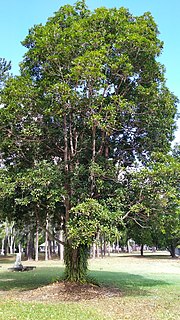
Elaeocarpus bancroftii, commonly known as Kuranda quandong, Johnstone River almond, ebony heart, grey nut, or nut tree is a large rainforest tree in the family Elaeocarpaceae which is endemic to Queensland. It has coriaceous leaves, attractive white flowers and relatively large fruit containing an edible kernel.

Endiandra discolor is an Australian tree, growing from near Gosford, New South Wales to Tully, Queensland in the tropics. Common names include rose walnut and domatia tree.
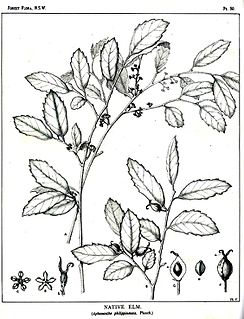
Aphananthe philippinensis is a common rainforest tree in the family Cannabaceae. In Australia it occurs from the Manning River in New South Wales to near Herberton in tropical Queensland. It was first described from the island of Luzon in the Philippines, hence the species name. The generic name of Aphananthe refers to insignificant flowers. This plant also occurs on the Solomon Islands and in Papua New Guinea

Ochrosia moorei, known as the southern ochrosia is a rainforest plant of eastern Australia. Endangered by extinction, it has a ROTAP rating of 2ECi.

Petalostigma triloculare, known as the long-leaved bitter bark is a rainforest tree of eastern Australia. It occurs in the drier rainforests, often on sandy soil derived from granite or sandstone, and is sometimes seen on old sand dunes.

Ehretia alba Retief & A.E.van Wyk is a semi-deciduous shrub or small tree up to 4m high, growing in Namibia, Botswana and the western, drier regions of South Africa, and was first collected by Hermann Merxmüller at Breitenberg in the Gobabis district of Namibia. As with other species of Ehretia it is twiggy with rigid branches, its fascicled leaves showing a large variation in size, with acute or obtuse apices, and appressed setae along margins. Midribs and secondary veins are prominent on the lower surfaces, while the petioles are only 3 mm long. Leaves are generally clustered or fascicled on abbreviated twigs. Flowers are fragrant and white to cream, while unopened buds are mauve. The mature fruit is red and shows a persistent calyx.
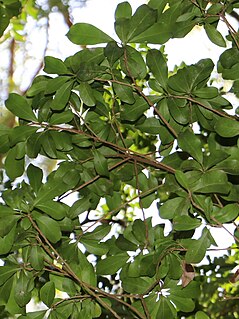
Fontainea venosa, also commonly known as southern blushwood, veiny fontainea, Queensland fontainea and formerly named as Bahrs scrub fontainea is a rare rainforest shrub or tree of the family Euphorbiaceae. It is found in southeastern Queensland, Australia, extending from Boyne Valley to Cedar Creek and is considered vulnerable due to several contributing threats. The total population size is around 200 plants.
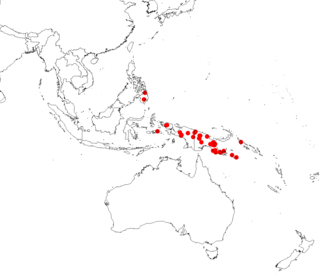
Parsonsia curvisepala is a woody vine of the family Apocynaceae, found in Malaysia, New Guinea, the Philippines, the Solomon Islands, and Sulawesi. This species is second only to Parsonsia alboflavescens in its variability and wide geographic distribution.
Fontainea fugax is a shrub endemic to Queensland, in the family, Euphorbiaceae, growing up to 4 m. In 1997, F. fugax was considered "endangered" having been found in only in the central Burnett district and within an endangered community, threatened by weeds, repeated fires and clearing.
Fontainea borealis is a small tree endemic to Papua New Guinea, in the family, Euphorbiaceae, which grows to a height of 12 m.
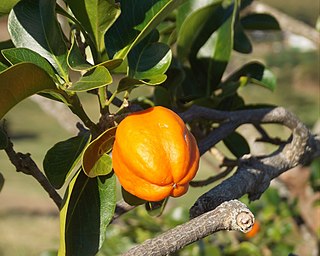
Fontainea pancheri is a small tree or shrub endemic to New Caledonia in the family, Euphorbiaceae, which grows to a height of 15 m.

Saribus brevifolius is a species of palm tree in the genus Saribus, which has only been found in the Kawe and Gag Islands in the archipelago of the Raja Ampat Islands, which lie off the north-west tip of the Bird's Head Peninsula in Indonesia's West Papua province. It was only discovered in 2002 during an expedition funded by The Nature Conservancy. The palm grows along the coasts of these two tropical islands on small ridges composed of ultrabasic rock. It is a moderately-sized fan palm with smallish and regularly segmented leaves and a smallish inflorescence in the crown. The inflorescence is not longer than the leaves, and split at its base into three main branches with one or more sub-inflorescences, these containing red flowers with pink anthers. The ends of S. brevifolius leaf segments are rigid and have a bifurcate cleft 1-4% of the segment length.

Pseudovanilla foliata, commonly known as the great climbing orchid, is a plant in the orchid family native to Queensland, New South Wales, and New Guinea. It is a terrestrial orchid with a vining vegetative habit, climbing by means of adventitious roots produced at nodes. Its leaves are reduced, and the species is considered to be at least partially mycoheterotrophic.
Pimelodendron amboinicum is a tree species in the Euphorbiaceae family. It is found from the Solomon Islands in the southwest Pacific, west to Sulawesi in Indonesia. The timber is used locally, though larger-scale illegal logging is apparent.

Syzygium claviflorum is a tree in the Myrtaceae family. It is native to the north of the Australian continent and in tropical and subtropical Asia. It is used for timber, as fuel, as human and cattle food, and for dye. Stunted specimens can be found on the top of the plateau of Bokor National Park, Cambodia.
















